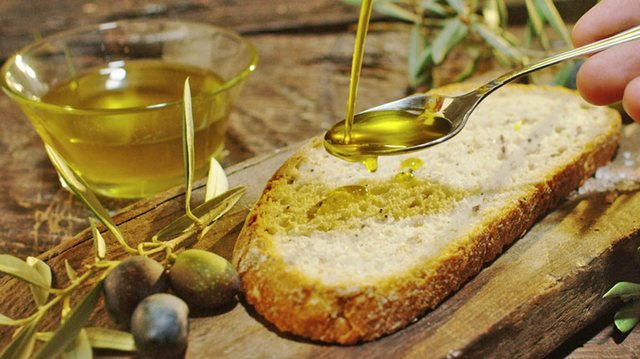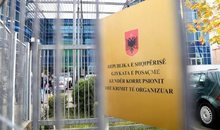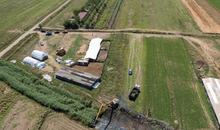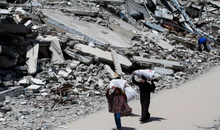
 Flash News
Flash News
Germany extends the stay of its troops in Kosovo
Greek police raid Albanian cells in Korydhalos, discover arsenal and drugs at "prison mafia boss"
The famous soprano of TKOB passes away prematurely
Sailing suspended due to bad weather in Vlora
Megaoperation/ Group based in Durres, names of Albanian traffickers revealed
Albania increases olive production, but the oil market faces challenges

Albania is a Mediterranean country known for olive production and year after year farmers are increasing the cultivated areas. Experts say that this year's olive production is better than last year, despite the consequences of climate change, with a dry summer. But according to specialists, the olive oil market continues to face many challenges and the level of exports remains low.
At the Center for the Transfer of Agricultural Technologies in Vlora, olive growers and processors are following the experts who talk about indigenous cultivars and the evaluation of olive oil in Albania.
Currently, the olive harvest and oil production season in the country is at its peak.
"This year is better than last year in terms of production", says Meno Besimaj who runs this center.
"This year it is expected to be over 120 thousand tons of olives, which means that the converts will increase oil production, despite the fact that the oil yield is not the same as last year due to temperature fluctuations and stress that created the olive plant from drought. The production capacity this year is good and all factories are at full capacity these days," he says.
Meanwhile, climate changes have affected the olive tree this year, according to specialist Adhurim Lazaj.
"This year follows the year 2023 with low production and the olive has a pronounced periodic production where one year produces more than the next. This year is expected to be a "full year" for olives, but due to the climatic conditions, especially at the time of flowering, the expected production was not achieved, but again, compared to last year, the production of grain olives is higher. ", he says.
According to the preliminary estimates of this center, production is expected to reach over 120 thousand tons of olives this year from 117,618 tons of olives, which was, according to the official data of the Institute of Statistics, in 2023.
This year, olive oil is sold by farmers or factories for 8 to 10 dollars per liter, from 5-6 dollars per liter last year.
Farmers are more satisfied this year because the price of oil is higher compared to previous years, says Mr. Besimaj.
One of the factors that is affecting the increased price of oil is the increase in the cost of harvesting olives since the labor force is scarce due to emigration in many areas, says Mr. Besimaj.
"The lack of labor means that the value of the working day has also increased. About 30% of the cost of olive production is the harvest alone. Despite the fact that olive harvesting is becoming mechanized as there are now many olive shakers with batteries and energy or with diesel and gasoline, but again the new work arm has left and most of them are forced to collect the olives and of course there is an increase in the cost of harvesting," he says.
While according to the olive specialist Adhurim Lazaj, care must be taken in the entire process from harvesting to oil production.
"Albania, he says, does not claim to compete in the global olive oil market with quantity as it has small areas with olives compared to countries in the region such as Greece, Italy or Spain, but aims to compete with the quality of the oil", he says .
"In order to obtain maximum quality, we must harvest it on time, the moment from harvesting to processing must be as short as possible. Preferably, within four hours of harvesting, the olives must go to be processed. If we keep the quantities of harvested olives for days, the decomposition starts and that's where the oil starts to spoil."
While Mr. Besimaj says that there is still a lot of work to be done, especially towards the marketing and packaging of olive oil to penetrate the regional market.
"Our factories are all new, state-of-the-art factories. There are two types of factories that Italy and Spain have, but since we entered this business late, we have newer ones and they are of high quality. The only thing we haven't normalized yet is the storage, packaging, labeling part and that's the marketing part that not all factories do. In 20 factories that we have inspected in the last few days, only two factories have the collection, marketing and certification part of olive oil", he says.
While Armando Lamaj, who has been involved in the production of olive oil for almost 5 years in the area of Drashovica in Vlora, says that the climate took its toll this year by reducing production for this area.
Mr. Lamaj processes the olives of the community in the area, but he intends to be involved in the marketing of olive oil abroad.
"As far as we can see, the olive oil market is advancing abroad. The quality of the oil was also very good this year. This year I plan to be involved in the olive oil export market and we will start the certification procedures."
Mr. Lamaj says that the oil processors need support from the state as they have increased costs, starting from the electricity that works in the factories, to the cost of collecting the production at the farmers and the increase in oil storage capacities.
According to customs data, Albania exported in the first nine months of this year about 2,400 tons of olive oil, while during the last year a total of about 6,100 tons of olive oil were exported.
Last year's exports were particularly linked to a quantity of olive oil stock created during 2022 which was exported to Italy following an agreement between the two countries.
According to the preliminary estimates of the national olive center in Vlora, this year the production of olive oil in Albania is expected to reach about 25 thousand tons, while in 2023, about 20 thousand tons of olive oil were produced at the national level./ VOA/
Latest news



Germany extends the stay of its troops in Kosovo
2025-05-21 22:19:22
Journalist: Xhevdet Troplini alongside a politician
2025-05-21 22:00:07
Amnesty International: Camps in Albania, a reflection of an inhumane system
2025-05-21 21:49:09
This is the first Albanian justice collaborator
2025-05-21 21:39:45
Bitcoin breaks historical record: Reaches $109,302
2025-05-21 21:36:06
Raped by colleague at the civil registry office, victim fired from job
2025-05-21 21:08:47
Hyn në fuqi vendimi i BSH/ Kredia për blerje banese kufizohet nga 1 korriku
2025-05-21 21:04:37
“Nga dhuna e burrit humba fëmijën”, nëna e dy të miturve kërkon drejtësi
2025-05-21 20:50:23
The government extends the stay of Ukrainians in Albania
2025-05-21 20:45:04
Social networks: Friend or foe of our personal relationships?
2025-05-21 20:22:33







The famous soprano of TKOB passes away prematurely
2025-05-21 18:27:50

Donald Trump's son says he might one day run for US president
2025-05-21 17:53:20

Israel's Eurovision result raises questions about voting
2025-05-21 17:23:29
Florence, two Albanians arrested with 23 kg of cocaine
2025-05-21 17:03:20
Sailing suspended due to bad weather in Vlora
2025-05-21 16:58:12
The abolition of the vote as a triumph of banality
2025-05-21 16:41:56


Operation "Bridge"/ Ekil Nderjaku is sentenced to "prison arrest"
2025-05-21 16:08:32

Who needs more physical exercise: Women or men?
2025-05-21 15:43:25
Former Ukrainian politician shot dead near a school in Madrid
2025-05-21 15:32:18
Operation "Bridge"/ Ekil Nderjaku is given another security measure in his cell
2025-05-21 15:22:37
Chocolate will reach high prices! Cocoa production in serious crisis
2025-05-21 15:11:34




"Grandma", "beast", the nicknames used by Albanian and Italian traffickers
2025-05-21 14:26:47
Pope Leo asks Israel to allow humanitarian aid into Gaza
2025-05-21 14:18:42

Document/ How did Nuredin Dumani hit Xhevdet Troplini's group of traffickers?
2025-05-21 14:05:45

Megaoperation/ Group based in Durres, names of Albanian traffickers revealed
2025-05-21 13:42:44
Former politician shot dead outside his children's school
2025-05-21 13:39:27
A ka BE-ja ende mjete efektive për t'i shkaktuar dhimbje Rusisë?
2025-05-21 13:26:33
Berisha: We will never accept such choices, no one can force us to accept them
2025-05-21 13:25:29




A 24-year-old man was found dead in Lake Farka.
2025-05-21 12:37:34

The abolition of the vote as a triumph of banality
2025-05-21 12:18:53

The only name for May 11th is: Electoral Terrorism
2025-05-21 12:06:25


Letter-order from Belgium, SPAK checks 4 premises, 33-year-old arrested in Berat
2025-05-21 11:37:31
Hajj 2025/ Everything you need to know about the annual pilgrimage to Mecca
2025-05-21 11:28:43

The appeal of the GJKKO leaves the head of the Road, Roven Zeka, in prison
2025-05-21 11:02:16

Kuçova! 66-year-old man sexually harasses 17-year-old girl
2025-05-21 10:41:40

Mental disorders and obesity threaten adolescents
2025-05-21 10:22:04


19 killed in Gaza by Israeli attacks, most of them children
2025-05-21 09:50:03
Tabaku: SP seeks to usurp independent institutions
2025-05-21 09:40:19



Is the Socialist Party's supermajority a danger to democracy?
2025-05-21 09:01:54


Video/ Explosives found at Veliera in Durrës, near Vangjush Dako's apartment
2025-05-21 08:32:15
The lack of flights at Vlora airport jeopardizes tourism guarantee contracts
2025-05-21 08:22:54
Horoscope, what do the stars have in store for you today?
2025-05-21 08:09:02

Morning Post/ In 2 lines: What mattered yesterday in Albania
2025-05-21 07:47:36







38 people arrested for conspiracy in Venezuela, among them an Albanian
2025-05-20 21:18:15

Torrential rainfall hits southeastern France, 3 confirmed victims
2025-05-20 20:49:14

Shehaj: Our votes will never unite with Edi Rama
2025-05-20 20:24:31
The ship "Butrinti" rescues 13 migrants in the Aegean Sea, including 2 children
2025-05-20 20:01:12
Video/ Revolt in Corfu prison, Albanians and Georgians set fire to cells
2025-05-20 19:51:04
Biden diagnosed with cancer, questions about his health in the White House
2025-05-20 19:37:01


